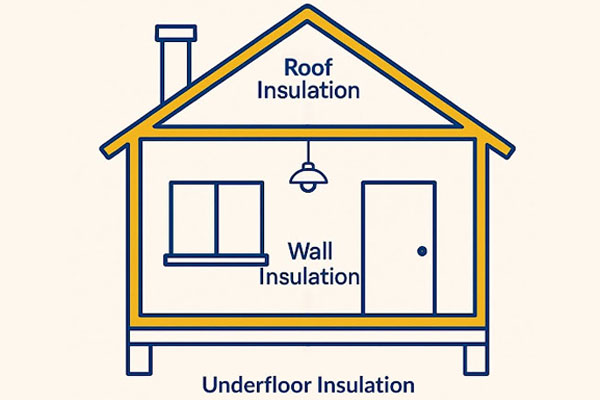
In Victoria, where we face scorching summers and chilly winters, home insulation isn’t just a nice-to-have; it’s an essential factor when you are concerned about a comfortable lifestyle. A well-insulated home offers year-round comfort and helps keep energy bills in check. But not all insulation is created equal. Wall, roof, and underfloor insulation each play distinct roles in your home’s thermal performance.
In this blog, we’ll break down the differences between each type to help you make informed decisions for your build or renovation.
Where it goes: Inside internal and external walls.
Standard materials: Insulation batts, foam panels.
Wall insulation forms a thermal and acoustic barrier between rooms and between indoors and outdoors. It’s especially valuable for maintaining consistent indoor temperatures and reducing noise transfer. Whether you’re renovating or building new, wall insulation enhances comfort and energy efficiency.
What’s the difference?
Roof insulation is installed directly under the roof surface, while ceiling insulation sits on the ceiling joists. Both aim to reduce heat transfer, but roof insulation offers greater summer heat protection, while ceiling insulation is essential for winter warmth.
Materials used: Glasswool batts, foil insulation, and insulation blankets.
Why it matters: In most Australian homes, up to 35% of energy loss occurs through the roof. Installing quality insulation here yields a high return on investment, enhancing comfort and significantly reducing cooling and heating costs
When it’s useful:
Underfloor insulation is ideal for homes with suspended timber floors or raised foundations. If your home is drafty or you find floors chilly in winter, underfloor insulation can make a big difference.
Benefits:
It reduces heat loss from below and adds a noticeable level of comfort, particularly in Victoria’s colder regions.
Standard materials: Foil boards and polyester or glasswool batts.
| Feature | Wall | Roof | Roof |
| Heat Retention | Medium | High | Low To Medium |
| Cost | $25 – $45 per m² (supply & install) (Costs may increase for retrofitting or where wall access is limited.) | $30 – $55 per m² (supply & install)(Roof space accessibility and pitch affect price. High ROI on energy savings.) | $20 – $40 per m² (supply & install)(Easier and cheaper for homes with good subfloor access.) |
| Ease of Install | Medium | Depends on access | Easy in raised homes |
| Materials Used | Glasswool batts, polyester batts, or foam panels | Glasswool batts, foil insulation, or blanket rolls | Foil boards, polyester or glasswool batts |
| Suitable For | Most Homes | All Homes | Raised Floors |
If you’re working with a limited budget, start with roof or ceiling insulation; this has the most significant impact on overall energy efficiency. Follow up with wall insulation to stabilise your home’s internal temperature and reduce noise. Lastly, if your home has timber or raised floors, underfloor insulation can prevent heat loss and cold drafts.
At OZ Homes Insulation, we tailor solutions based on your home’s structure, climate, and budget. We’ll help you choose the right type, or combination of insulation, to maximise comfort and performance.
Each type of insulation serves a distinct purpose, and when combined, they deliver the best results for year-round comfort and energy efficiency. Whether you’re building a new home or upgrading your existing one, it’s worth getting professional advice.
Contact OZ Homes Insulation today for expert guidance and a free quote. Let’s keep your home comfortable, efficient, and future-ready.
Quick Quote
Our team are well placed to advise you on the right insulation products for your construction project.
Our team are well placed to advise you on the right insulation products for your construction project.
Dear Valued Customer,
Thank you for visiting Oz Homes Insulation, we will finish trading for the year at 5:00pm Monday 18th December 2023 and re-open for business on Monday 15ndJanuary 2024
Our phone will not be attended during these times so please email through all enquires via our email or simply fill out our call back form with your enquire and will get back to you as soon as possible.